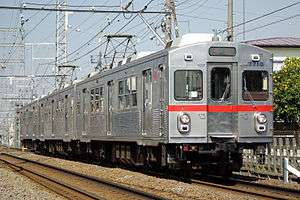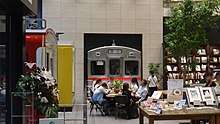Tokyu 7700 series
| Tokyu 7700 series | |
|---|---|
 7700 series set 7910 on the Tokyu Ikegami Line in February 2007 | |
| Manufacturer | Tokyu Car Corporation |
| Constructed | 1987-1990 |
| Entered service | 1987 |
| Scrapped | 2000- |
| Number built | 56 vehicles |
| Number in service | 18 vehicles (6 sets) (as of 1 April 2016) |
| Number preserved | 1 vehicle (cab end only) |
| Formation | 3 cars per trainset |
| Fleet numbers | 7901-7915 |
| Operator(s) | Tokyu Corporation |
| Line(s) served |
Tokyu Ikegami Line Tokyu Tamagawa Line |
| Specifications | |
| Car body construction | Stainless steel |
| Car length | 18,000 mm (59 ft 1 in) |
| Doors | 3 pairs per side |
| Maximum speed | 85 km/h (55 mph) |
| Traction system |
Variable frequency (GTO) (sets 7901-7914) Variable frequency (IGBT) (set 7915) |
| Electric system(s) | 1,500 V DC |
| Current collection method | Overhead wire |
| Track gauge | 1,067 mm (3 ft 6 in) |
The Tokyu 7700 series (東急7700系 Tōkyū 7700-kei) is an electric multiple unit (EMU) train type operated by the private railway operator Tokyu Corporation on the Tokyu Ikegami and Tokyu Tamagawa lines in Japan since 1987.[1]
Design
The 7700 series trains were formed between 1987 and 1990 using the bodies of former Tokyu 7000 series trains dating from the 1960s, which were modernized with air-conditioning and mated with new bogies and VVVF drive.[1] Cars are 18 metres (59 ft 1 in) long and have three pairs of doors per side.[1]
Operations
The trains are formed as three-car sets and used on the Tokyu Ikegami Line and Tokyu Tamagawa Line.[1]
Formations
As of 1 April 2016, the fleet consists of six three-car sets, formed as follows, with two motored ("M") cars and one non-powered trailer ("T") car, and car 1 at the Gotanda/Tamagawa end.[2]
| Car No. | 1 | 2 | 3 |
|---|---|---|---|
| Designation | Tc | M | Mc |
| Numbering | 79xx | 78xx | 77xx |
Cars 2 and 3 are each fitted with one lozenge-type pantograph.[2]
Interior
Passenger accommodation consists of longitudinal seating throughout, with a mixture of brown and orange seat moquette.[1]
 The interior of intermediate car 7810 in February 2007
The interior of intermediate car 7810 in February 2007
History
The 7700 series trains sets were initially formed as two- and four-car sets, however the fleet was subsequently reformed into three-car sets.[1] Set 7915 was formed in 1996 from three former intermediate cars, and had newly-added cab ends of the same design as the Tokyu 1000 series and Tokyu 9000 series trains.[1] This set was withdrawn in 2010.[1]
 Set 7915 in November 2006
Set 7915 in November 2006
Livery variations
- Set 7910 in original unpainted livery in May 2012
 Set 7901 in February 2007
Set 7901 in February 2007 Set 7914 in October 2006 in the "Kabuki" livery applied to driver-only operation sets
Set 7914 in October 2006 in the "Kabuki" livery applied to driver-only operation sets
Withdrawal and resale
Withdrawals commenced in 2000, with six end cars being resold to the Towada Kankō Electric Railway in Aomori Prefecture.[1] While these three two-car sets retained the "7700 series" classification, they were renumbered 7701+7901 to 7703+7903, irrespective of their original car numbers.[3]
Preserved examples

The cab end of former car DeHa 7702 is preserved inside the Maruzen Ikebukuro bookshop in Toshima, Tokyo. Built in March 1966 as 7000 series car DeHa 7046, it was withdrawn in December 2015, and moved to the ground floor of the Maruzen Ikebukuro bookshop building in March 2017, while still under construction.[4]
References
- 1 2 3 4 5 6 7 8 9 私鉄車両年鑑2015 [Japan Private Railways Annual 2015] (in Japanese). Tokyo, Japan: Ikaros Publications Ltd. 20 June 2015. p. 187. ISBN 978-4-8022-0003-5.
- 1 2 私鉄車両編成表 2016 [Private Railway Rolling Stock Formations - 2016] (in Japanese). Japan: Kotsu Shimbunsha. 25 July 2016. p. 62. ISBN 978-4-330-70116-5.
- ↑ 私鉄車両編成表 2011 [Private Railway Rolling Stock Formations - 2011] (in Japanese). Japan: Kotsu Shimbunsha. July 2011. ISBN 978-4-330-22711-5.
- ↑ Goto, Fumio (October 2017). 東京・池袋 ビルに入った3台の電車 [The three trains inside a building in Ikebukuro, Tokyo]. Japan Railfan Magazine (in Japanese). Vol. 57 no. 678. Japan: Koyusha Co., Ltd. p. 78-81.
External links
| Wikimedia Commons has media related to Tokyu 7700 series. |
- Tokyu EMU details (in Japanese)
